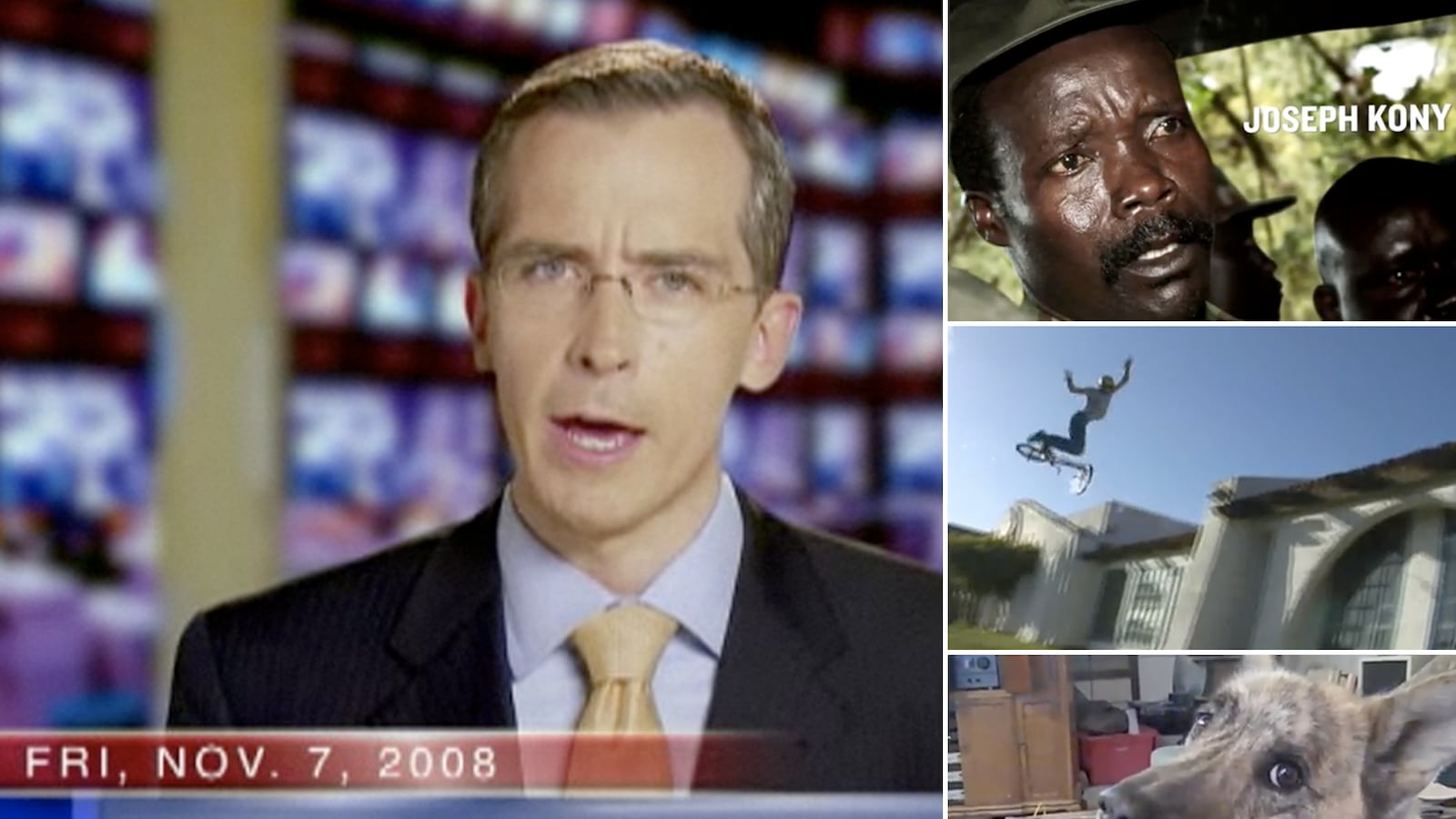Now and then, a video with real social relevance goes viral, the most obvious example being Kony 2012. But far more often, videos that capture the zeitgeist and spread like wildfire across the Internet are celebrity-driven, shocking, or just dumb fun, like that talking dog. Rarely do viral videos have both entertainment value and something important to say. Upworthy, which launched just a few weeks ago, wants to change that.
The Internet brainchild of Peter Koechley, former managing editor of the The Onion, Eli Pariser, board president of MoveOn.org and founder of Filter Bubble, and Chris Hughes, co-founder of Facebook and new owner of The New Republic, Upworthy is a viral aggregator that provides curated daily picks via Pinterest, Facebook, Twitter, and email newsletters. Its founders have their sights set on the The Daily Show generation that wants to be entertained and informed at the same time.
“The Internet is becoming increasingly inane and less meaningful, and we want to be a force to counteract that,” Koechley told the The Daily Beast in his first in-depth interview since launching the site. “We know this is no small task, but we’d like to see videos and other Web content about things that matter in the world be as entertaining as that guy biking off his roof. Stuff that means something doesn’t have to be boring, depressing, or guilt-inducing, and the fun stuff doesn’t have to be totally without substance. We want to be the source for viral content that is socially significant but still fun.”
Koechley knows a thing or two about viral videos. In 2008, he created one while working as MoveOn’s campaign-innovation director that used shame, and humor, to get people to vote for Barack Obama for president. The video, which was a faux broadcast news report that described the world’s angry reaction to one voter who didn’t vote and cost Obama the election, was distributed just a week before the real election. Somewhat reminiscent of the Kevin Costner populist political film "Swing Vote" that was released that year, the video got some 23 million hits, Koechley noted proudly.
So does he take credit for Obama being elected? “Oh, yes, 100 percent,” cracked Koechley, a sort of modern-day Norman Minow, the former Federal Communications Commission chair who, like Koechley, was very active in Democratic Party politics and who made national headlines in the early 1960s when he called television a “vast wasteland.” Five decades later, Koechley is saying the same thing about the Internet. But just how much real change he and his colleagues at Upworthy can effect remains to be seen. The site’s quest is noble, if quixotic. Can these guys, even with their proven online track record, really have a measurable affect on something so vast as the Web, which, according to a Netcraft survey released in March, has more than 644 million active websites?

The early returns look somewhat promising, but far from conclusive. Although the site is only a month old, Upworthy has already had its first success with an animated video it discovered from MissRepresentation.org, an organization that, according to its website, seeks to “empower women and girls to challenge limiting media labels in order to realize their potential.”
While MissRepresentation.org’s video, which addresses young girls’ consumption of mass media and how it influences their lives, their self-esteem, and their potential as leaders, is fast-moving and engaging, with a rock ’n’ roll background and colorful and easy-to-digest graphics filled with eye-opening facts, it hadn’t found a large audience.
But then Upworthy discovered and posted the video and within a couple of weeks it had gone from just over 1,000 views to more than 150,000, and that number grows daily.
Imran Siddiquee, social-media and communications manager for MissRepresentation.org, said Upworthy has already made a big difference for his organization. “We’re very big on social media as a part of our mission to show how women are under-represented,” said Siddiquee. “We had initially released the video in February for International Women’s Day. We spent a lot of time promoting it in February and sent out press releases. We didn’t even realize how many hits the video had gotten until Upworthy reached out to us and told us they had posted it.”
With Upworthy, packaging is also key. Before posting the video, an Upworthy curator came up with a new headline: “What Happens to 3 Out of 4 Girls After Leafing Through a Fashion Mag for 3 Minutes?” Then it was posted, and quickly people started sharing it.
“What’s most exciting about this is that our message is now reaching new and different populations—which ultimately is the point,” Siddiquee said. “We’re trying to shift the way our culture thinks of and values women and girls, and change is only going to happen if we can create viral moments like this, where the larger public takes notice. The people at Upworthy have experience with this. The key is that they’re posting videos that they know people will want to share with others, they only want content that is both entertaining and about something important in our lives. They’re trying to change the world and make the Internet a more meaningful place. I think they will help a lot of organizations and causes; they’ve already helped us.”
Koechley said one of Upworthy’s secrets to finding these videos is that they look for the ones packed with emotion: “Whether it’s joy or anger or whatever, the videos that elicit genuine emotion are the ones that captivate and have the best chance of going viral.”
Of course, as with any Web startup there is the inevitable Big Question: How will Upworthy make money? “The plan is to make money by simply helping organizations expand their reach,” explained Koechley. “We are not a pay model for users, and we don’t have ads. Our role is to find content that people will want to share with other people and in turn help organizations spread the word. We want to remind people of the best instincts inside them and connect them with the appropriate organizations. We’re confident those organizations will pay for this.”
By the way, it’s not just videos Upworthy wants to propagate, it’s also photos and graphics like this simple but effective one titled “How Many Years Has American Been at War Since 1776” (the answer might shock you). “We’ve all seen photos and graphics go viral,” Koechley said, adding that Upworthy is interested in just about anything that you might see on Tumblr, the site that allows you to post text, photos, quotes, links, music, and videos.
A virtual operation—there is no “Upworthy HQ,” though both Koechley and Pariser live in Brooklyn—Upworthy has no plans at this point to create its own content. There’s plenty of stuff already out there, it’s just a matter of finding it, they say. Its curators, who are located everywhere from Los Angeles to Cleveland, find content in a variety of ways—some both scientific, some simply intuitive. They employ several algorithms, but they also scour the Internet, of course, including Facebook walls, and they created their own dummy Facebook page to see what people are already talking about. Among their distribution vehicles is a daily email blast called The Upworthiest, which includes the curators’ top picks.
Despite claims by Koechley and on its website that Upworthy is nonpartisan, there is clearly an agenda that reflects the entire Upworthy team, most of whom are well-known progressives. Before launching, Hughes, who led Obama’s online organization during his 2008 presidential campaign and who, in addition to being Upworthy’s biggest financial backer, is an adviser who sits on its board, reportedly described jobs at Upworthy as being for people who “love Facebook and hate Fox News.”
But, noted Koechley, “Our curators disagree on issues and on what videos we should be promoting, we are not monolithic, and we do not identify as either Democrat or Republican. We do however care about issues. Let me put it this way: we think gay marriage is good and we think child poverty is bad. And even if we discovered a great video that said climate change is a hoax, we wouldn’t post it.”
Koechney also insists that the curators are diligent about not posting videos with bogus facts. “We’re very careful about the videos and content we post,” he said, adding that they’ve already posted one correction. “It was from CNN,” he said with a laugh.
Koechley admits he and the rest of the Upworthy crew have lofty ambitions. “We’ve only been up one month, but we’re feeling good about the initial connections we’re making,” he said. “Obviously the scale of problems in the world is large. But we want to make a difference. We want and expect our company name to eventually become a household word, as in, ‘Hey, that video is definitely ‘upworthy.’ ”






